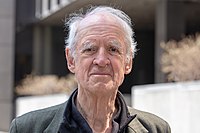
Photo from wikipedia
In my paper, I set The Language Animal against a broader picture of Charles Taylor’s intellectual trajectory. Sources of the Self (1989) left open three major questions: (a) the viability… Click to show full abstract
In my paper, I set The Language Animal against a broader picture of Charles Taylor’s intellectual trajectory. Sources of the Self (1989) left open three major questions: (a) the viability of religious moral sources in a ‘secular’ age; (b) the compatibility between a robust moral realism and a genealogical account of modern identity; and (c) the meaning and destiny of the so-called ‘linguistic turn.’ This is the framing topic of his last book. Although Taylor’s variety of hermeneutics is unquestionably a product of the linguistic turn, he has operated with a broad notion of the linguistic capacity from the start. Language is, for him, a shared activity and the acknowledgment of its animal embeddedness functions in his work as an antidote against any too idealized a view of the kind of creatures that humans are. In his earlier writings, however, a structural tension lurked below the surface between a Gadamerian notion of Sprache and a more phenomenological, Merleau-Pontyan, embodied outlook that was less modelled on articulate speech. My claim is that his new book marks a shift from a more speech-oriented to a more body-oriented understanding of language. Dans mon article, j’analyse The Language Animal sur la base d’une considération plus large de la trajectoire intellectuelle de Taylor. Les sources du moi (1989) laissait trois grandes questions en suspens : (a) la pérennité des sources morales religieuses dans un âge «séculier»; (b) la compatibilité d’un réalisme moral robuste avec un récit généalogique de l’identité moderne; (c) le sens et le destin du soi-disant «tournant linguistique». Cette dernière question est devenue la question-clé de son plus récent livre. Bien que la variété de l’herméneutique taylorienne soit incontestablement le produit du tournant linguistique, Taylor a travaillé dès le début avec une conception large de la capacité linguistique. Le langage est pour lui une activité partagée et la reconnaissance de ses origines animales joue dans son travail un rôle d’antidote contre une vue trop idéalisée du type de créature que sont les humains. Dans ses premiers écrits, cependant, se dissimulait une tension structurelle entre une notion gadamerienne de Sprache et une perspective plus phénoménologique, liée à Merlau-Ponty et à la notion de parole incarnée, moins modelée sur la parole articulée. J’avance que ce nouveau livre de Taylor marque le passage d’une conception du language axée sur la parole à une conception davantage axée sur le corps.
Journal Title: Dialogue
Year Published: 2017
Link to full text (if available)
Share on Social Media: Sign Up to like & get
recommendations!